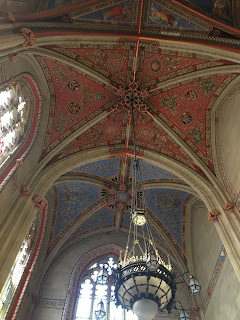On Friday March 23rd, we visited the juvenile detention center in Zurich. When we arrived at Zurich’s facility, I thought there had been a mistake. The building was located in Switzerland’s rolling hills and looked like a large cottage, complete with Europe’s signature architecture. It did not look like a place where individuals who had committed a crime resided. We began with a lecture by Dr. Evi Forgó Baer, who is a part of the team of 10 psychologists and psychiatrists that work with what they call “clients.” Her specialty is in music perception and empathy in juvenile and young adult offenders, which was the first clue that Switzerland’s system would be extremely different from the one in the U.S.
 |
| Our first impression of Zurich's detention facility |
 |
| A view into the courtyard that the "clients" can take breaks in |
When we sat down for the lecture, each one of us had a small porcelain bunny on the table in front of us, and Dr. Baer explained that her clients had made them for us. She went on to discuss the importance of using ways other than spoken language to get through to her clients, such as music therapy and art therapy, hence the bunnies that they had made. All of the men that reside there are between the ages of 16 and 26 and have committed severe offenses. Her clients do not want to talk to her about their problems and have low motivation to change, and so she uses nonverbal forms of therapy to give her a better understanding of their personalities. After her explanation of the nonverbal therapies, she brought in one of her clients to play the piano for us. She explained that he used to not like to be talked to or touched, and music completely changed his demeanor. He came in, introduced himself, and sat down at the piano. He began to play, and I could not believe how beautiful the song was. It began with light and airy notes that eventually transformed into a deeper, more meaningful tune. It conveyed a sense of sadness with a hint of hope. I looked around the room, and a few of my classmates were wiping their eyes. Once he was finished, we all gave him a standing ovation. Caroline, one of my classmates, described it as “beautiful and touching to watch.” After only being at the facility for two and a half years, he had learned to make music as a form of expression, which is exactly the goal of music therapy that Dr. Baer described. He and his music were shining examples of the nonverbal communication that the facility uses as transformative means of both communicating and progressing.
After the performance, we followed the man who played the piano to the workshop that he works in. He works for 8 hours every week day, and he showed us a few of the pieces that he has created. At the time, he was working on making a bar out of oak wood. We said our good-byes and went downstairs to a shop in which all of the items for sale are made by the men who reside there. There were chairs, tables, flowers that they had grown, and sculptures. Their work portrayed exactly how meaningful and far-reaching the work that is done at Zurich’s detention center, both for the clients and society as a whole. Their goal is to improve these men, despite the crime that they have committed, and release them into society with the intention of bettering it.
 |
| Wood pieces available for sale in the shop |


























